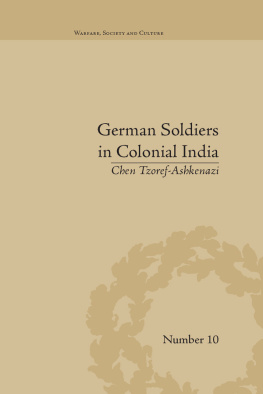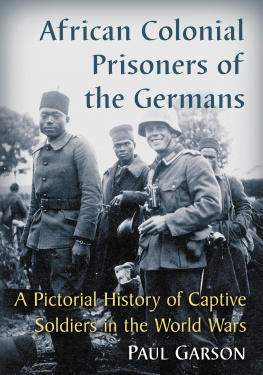German Colonial Wars and the Context of Military Violence
SUSANNE KUSS
Translated by Andrew Smith
Cambridge, Massachusetts
London, England
2017
English translation 2017 by Susanne Kuss
All rights reserved
An earlier version of this work was first published as Deutsches Militr auf kolonialen Kriegsschaupltzen: Eskalation von Gewalt zu Beginn des 20. Jahrhunderts Christoph Links Verlag GmbH, Berlin 2010.
The translation of this work was funded by Geisteswissenschaften InternationalTranslating Funding for Humanities and Social Sciences from Germany, a joint initiative of the Fritz Thyssen Foundation, the German Federal Foreign Office, the collecting society VG WORT, and the Brsenverein des Deutschen Buchhandels (German Publishers & Booksellers Association).
Jacket image: The Germans to the Front (1902) by Carl Rchling
Jacket design: Lisa Roberts
978-0-674-97063-2 (alk. paper)
978-0-674-97758-7 (EPUB)
978-0-674-97757-0 (MOBI)
978-0-674-97735-8 (PDF)
The Library of Congress has cataloged the printed edition as follows:
Names: Kuss, Susanne, author.
Title: German colonial wars and the context of military violence / Susanne Kuss ; translated by Andrew Smith.
Other titles: Deutsches Militr auf kolonialen Kriegsschaupltzen. English
Description: Cambridge, Massachusetts : Harvard University Press, 2017. | An earlier version of this work was first published as Deutsches Militr auf kolonialen Kriegsschaupltzen: Eskalation von Gewalt zu Beginn des 20. Jahrhunderts (c) Christoph Links Verlag GmbH, Berlin 2010Title page verso. | Includes bibliographical references and index.
Identifiers: LCCN 2016040430
Subjects: LCSH: GermanyHistory, Military20th century. | MilitarismGermanyHistory20th century. | Maji Maji Uprising, 19051907. | NamibiaHistoryHerero Revolt, 19041907. | NamibiaHistoryNama Revolt, 19041908. | ChinaHistoryBoxer Rebellion, 18991901. | Imperialism.
Classification: LCC DD104 .K8713 2017 | DDC 909/.09712430821dc23
LC record available at https://lccn.loc.gov/2016040430
Contents
T HE AIM of this study is to analyze the causes and forms of the violence perpetrated by the German Empire within the context of three major colonial wars fought at the turn of the twentieth century: the Boxer War in China (19001901), the Herero and Nama War in German South-West Africa (19041907), and the Maji Maji War in German East Africa (19051908). Although long sidelined in German historiography, the issues raised by these conflicts touch on some of the central and abiding questions of modern German history: development from imperial Germany to the Third Reich and the continuities between these two systems. Intricately associated with the so-called Sonderweg thesis, first postulated by Fritz Fischer and Hans Ulrich Wehler, later proponents of this highly controversial theory argued that the seeds of Nazism lay within these minor conflicts.
Despite originating at the interface between military and colonial history, historical treatments of the colonial wars remained the preserve of scholars of imperial and commonwealth history. Colonial studies in Germany grew out of Hannah Arendts appreciation that, far from being a twentieth-century phenomenon, totalitarianism had first developed in the European colonies.Although not considering Germany or the military and its practices in any great detailthe literature focused on British administrators, technocrats, and bureaucratsthe theory remained flexible enough to be applied to the German context. The end of the 1960s saw the development of a number of specialist studies concentrating on the former German colony of South-West Africa. Studies conducted in both East and West Germany identified continuities in the system of rule spanning Wilhelmine colonialism to the expansive policies of the Third Reich; the latter was identified in nascent form in the administration of German South-West Africa.
The postcolonial turn in history in general and the cultural turn in military history in particular also had an impact on research into the German colonial wars. Previous studies of the conflicts examined in this book restricted themselves to a straightforward analysis of their genesis, course, and aftermath. A new approach now widened the focus to incorporate such disparate aspects as the influence of the press, propaganda, and military literature on the course of the wars; the question of gender in East Africa; the participation of African and Chinese auxiliaries; and the significance of the Herero war for the history of the Herero people and the Namibian nation. The development of a number of comparative studies contrasting the German wars with those conducted by their imperial rivals added an international component to what had previously been an exclusively national debate.
These developments provided the backdrop to the emergence of a new generation of historians advocating the continuity from German South-West Africa to National Socialism in the way in which violence was exercised against subject populations. The discussion of the interrelationship between the colonies and the metropole raised questions of colonial and European practices of violence and National Socialism as a form of colonial rule. Within this debate, the Herero and Nama War was repurposed as the hinge between imperialism and National Socialism, the crimes of the fathers committed in a much smaller and non-European framework merely anticipating those perpetrated by their sons some forty years later.
The concept of a specifically German collective military disposition, born in 1871 and documented for both the colonial wars and the First World War, was seen to reach its apogee in the war of racial destruction unleashed in Central and Eastern Europe after 1939. Advancing the existence of a putative German military culture consisting of a range of unarticulated dispositionsassumptions, principles, values, standards, tenets of faith, and formal knowledgeand expressed in stated doctrines, some scholars argued that it formed a clear mindset influencing or even determining military behavior.
Others viewed the path from Windhoek to Auschwitz as much less direct, advancing three arguments to this effect. The youngest of the empire builders were sixty years of age in 1941. Indeed, the indirect transmission of genocidal practices via a putative institutionalized military memory specific to Germany was not only extremely difficult to demonstrate but nearly impossible to assess. This personnel argument was augmented by the realization that the mass murder committed in 1904 was the immediate responsibility of a number of small units consisting of only a few thousand men. This raised the question as to the true significance for later German wars of the experiences of only a handful of soldiers.
Neither the Wehrmacht nor Hitler attempted to justify the Eastern campaign by reference to the German colonial wars. An important precondition for the continuity theory is the preservation and transmission of such experiences within the military establishment in the form of reports or doctrines. However, the opposite is the caseneither the Reichswehr nor the Wehrmacht commissioned or made recourse to any study of the German colonial wars from which to learn lessons for the future. Although advancing a range of arguments striking in their clarity, resting on analogy and assumption, the advocates of the continuity theory fail to demonstrate that the extreme violence practiced in the Second World War actually derived its central causal impetus from the war in German South-West Africa.









